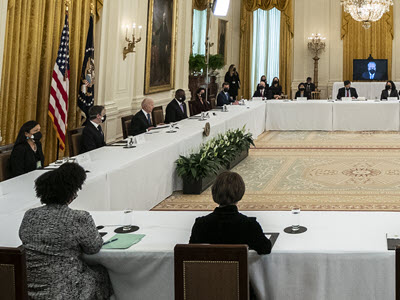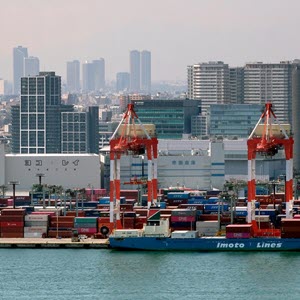Prospects for U.S. Trade Engagement in the Indo-Pacific and Options for the Biden Administration
Charles W. Boustany Jr. examines several domestic and international factors that will shape the Biden administration’s trade policy and offers insights into the challenges, opportunities, and prospects for engagement in the Indo-Pacific region.
The direction and priorities of the Biden administration’s trade policy are beginning to come into focus now that the president has published his 2021 trade policy agenda and 2020 annual report on the status of the trade agreements program. The immediate priority appears to be the development of resilient supply chains to address challenges that have emerged throughout the Covid-19 pandemic and prepare for future public health crises with an added emphasis on the role of small businesses in these supply chains.
Other key priorities include addressing the opportunities and challenges of the digital economy; opening markets to create U.S. jobs and increase wages; preparing for any disruptions in the global trading system; enforcing existing trade agreements; advancing environmental standards to achieve net-zero emissions by 2050; using trade policy to help underserved communities and promote racial equity; developing an economic strategy for competition with China; and partnering with allies to reform the World Trade Organization (WTO). Policy details remain to be defined to clarify how these ambitious objectives might be achieved and how conflicts between competing objectives will be managed or resolved.
President Joe Biden has also issued two executive orders pertaining to trade policy. The first expands on the existing Buy American program and centralizes its oversight in the Office of Budget and Management. The second launches an extensive two-tiered review of supply chains from which policy recommendations are sure to follow. President Biden and others in the administration have indicated that no new trade negotiations will be undertaken until significant investments are made in the American worker and infrastructure. The administration has not yet indicated whether it will ask for renewal of Trade Promotion Authority (TPA), which expires on June 30. As of now, reauthorization does not appear to be an immediate priority. Interagency reviews and planning are also underway regarding both China and the climate.
Several factors, both domestic and international, will determine the contour of the Biden administration’s trade policy. The remainder of this essay will examine these factors and offer insights into the challenges, opportunities, and prospects for engagement in the Indo-Pacific region.
INTERNATIONAL AND REGIONAL DEVELOPMENTS AFFECTING U.S. TRADE POLICY
The Indo-Pacific experienced a higher growth rate than either North America or Europe for trade in goods in the decade spanning 2008 to 2018. Inbound and outbound FDI in the region also reached unprecedented levels in 2018.[1] Political and economic uncertainty in 2019—in part due to the escalation of trade tensions between China and the United States—resulted in a decline in both trade and FDI as other countries enacted protectionist measures while supply chain restructuring accelerated. In 2020 the pandemic further decreased the value of trade and FDI. The emergence of countries in Northeast Asia from pandemic lockdown earlier than in the United States and Europe, however, led to a rebound in regional trade and FDI. The Indo-Pacific is likely to continue as the most dynamic region in the world for trade and investment in the coming years.
Three trends affecting economic growth in the post-pandemic world will drive trade and FDI. First, acceleration of the digitalization of the economy, which proved vital during the pandemic, will be a key driver in the development of global value chains and investment. As trade in goods and services becomes more linked within global value chains, regional economies will likely become more integrated. In addition, the development of standards for the operation of the digital economy in the Indo-Pacific may well influence the adoption of standards more widely—a trend that has significant implications for U.S. engagement in the region.
Second, the pandemic has led to efforts to restructure global value chains in response to disruptions. To achieve resilience and cost optimization, the restructuring of value chains appears to be trending toward regionalization. The temptation to adopt protectionist measures by some countries in response to these trends will complicate the landscape of restructuring. The continuation of U.S. protectionist measures put in place by the previous administration, coupled with strict reshoring policies and more restrictive procurement measures by the Biden administration, could put the United States at a distinct disadvantage in the Indo-Pacific. Washington will need to develop policies that strike an appropriate balance between achieving resilience in global value chains through cooperation with allies and addressing national security concerns.
Third, new trade and investment agreements have proliferated in the Indo-Pacific since the United States withdrew from the Trans-Pacific Partnership. The Comprehensive and Progressive Agreement for Trans-Pacific Partnership (CPTPP) was signed by the remaining eleven countries, and the United Kingdom is now actively taking steps to join. Other countries in the region are also working to join the agreement. American farmers and manufacturers have already noted less favorable market access for their products as a consequence of this agreement. In reaction, the previous administration entered into a nonbinding partial trade agreement with Japan.
The Regional Comprehensive Economic Partnership (RCEP) signed by the ten Association of Southeast Asian Nations (ASEAN) members, China, Japan, South Korea, Australia, and New Zealand covers nearly 30% of global GDP. It is the first formal agreement to include China, Japan, and South Korea. Once implemented, the RCEP is likely to hasten the current pace of economic integration in the region. China’s centrality in global value chains is thus likely to continue in the absence of formal U.S. engagement.
The European Union has also taken active interest in the Indo-Pacific. Since 2018, it has signed bilateral agreements with Japan, Singapore, Vietnam, and China, and negotiations are underway with ASEAN, Australia, and New Zealand. These agreements would link the global value chains of two of the world’s major manufacturing hubs (Europe and Northeast Asia) and possibly further disadvantage the United States. Two countries belonging to the North American hub (Canada and Mexico) are part of the CPTPP, which provides connectivity to Asia for those two countries. Without a strategy for formal economic engagement in the Indo-Pacific, the United States could face less favorable terms for market access and reduced influence in the development of standards for trade, investment, and technology.
The Indo-Pacific is continuing on a trajectory marked by robust growth in the volume and value of trade and investment relative to North America and Europe. As the development and integration of global value chains accelerates in the region, driven by trade agreements and market conditions, countries are hoping for heightened U.S. engagement as a balance to both the gravitational pull of the Chinese market and the centrality of China in these global value chains. Beyond the economic benefits for the American worker, active formal engagement will bolster a greater sense of security for regional countries and thereby potentially lower the cost for the United States in providing security.
CHALLENGES FOR U.S. ENGAGEMENT
The Biden administration will confront three main challenges in trade policy that will affect the prospects for active formal engagement with the Indo-Pacific. First, it will have to contend with a closely divided Congress focused on the 2022 midterm elections. Both parties will be seeking to gain an electoral advantage. Further complicating the political environment is the factional division within the two parties. Democrats are divided into a progressive faction inclined toward protectionism and a centrist faction more favorable to international economic engagement. Republicans now lean heavily toward economic nationalism and protectionism, with a smaller faction of establishment Republicans inclined toward international economic engagement. The Biden administration will have to navigate this political terrain in Congress to build support for its trade policy. Administration officials have emphasized “worker-centric” policies and suggested that no new trade agreements will be sought until problems affecting the domestic economy are addressed. Such statements in part signal to economic populists, unions, and economic nationalists a desire to build a coalition of support. Heightened political division raises the risk of delay or obstruction of a trade agenda to a level beyond the historical contention surrounding trade policy.
Second, the formulation and implementation of trade policy, which are traditionally the purview of the U.S. Trade Representative (USTR) under the president’s direction, will be spread among the State Department, National Security Council, and White House senior staff, in addition to the USTR. Competition among these poles of influence will add to the complexity of decision-making regarding the direction and priority of trade policy.
Third, the Biden administration has set a number of trade goals, as described in the introduction. The potential for direct conflict between competing priorities raises another layer of complexity for trade policy. For instance, the challenge of reconciling protectionist instincts stoked by labor unions and their allies in the administration with a trade policy focused on engagement presents a real risk of inaction.
OPTIONS FOR THE BIDEN ADMINISTRATION
Regional approach: Renegotiate entry into the CPTPP. Joining the CPTPP is perhaps the strongest means for the Biden administration to engage the Indo-Pacific. It would give the most assurance to U.S. allies and trading partners in the region that the United States is fully committed to a robust economic policy that complements its role in security. Successful negotiations leading to accession would also create the greatest influence on the development of standards for participation in global value chains, investment, and technology.
Entry in the CPTPP, however, would require congressional ratification, giving it the force of law and assuring allies and trading partners of a long-term commitment. The Biden administration would face an uphill battle to obtain both congressional support for TPA (an important prerequisite) and subsequent ratification following what might be protracted negotiations for the necessary modifications for accession.
Sectoral agreements focused on supply chains. The Biden administration might choose to focus on sectoral agreements in areas such as pharmaceuticals, medical technology, environmental goods, telecommunications, and digital trade. These agreements could potentially be implemented quickly through executive actions without congressional approval. The ongoing supply chain review may lead the Biden administration to focus on this approach to avoid contentious congressional politics.
There are several downsides, however. Enforcement could be an issue if the agreements are nonbinding. Without ratification by Congress to signal U.S. commitment, concerns about withdrawal will create an element of uncertainty for both governments and businesses. Finally, sectoral executive agreements may not have the same direct impact on the development of standards, especially if they are competing with ratified formal agreements. On the other hand, sectoral agreements could be used as building blocks for a regional high-standard agreement.
WTO reform and emphasis on enforcement. The Biden administration may choose to focus on WTO reform and revitalization of that organization as the focal point for trade policy. This could be done with added emphasis on the enforcement of existing trade agreements. Such an approach would be consistent with the administration’s emphasis on strengthening multilateralism and could be combined with the sectoral approach in negotiating steps to achieve reform. The downside is the immense difficulty in building the necessary consensus to actually reform the WTO. Although this approach avoids contentious congressional politics, it is unlikely to match the pace of developments in the Indo-Pacific.
CONCLUSION
The Biden administration is correctly focused on quelling the pandemic and managing the economic fallout. Once these challenges are under control, its focus will then shift to the likely next phase of rebuilding a strong middle class and critical infrastructure while signaling a return to international engagement. What appears to be the least risky approach to trade policy and engagement in the Indo-Pacific from the standpoint of domestic politics is to combine a vigorous return to multilateral diplomacy with sectoral agreements and trade enforcement. By doing so, the administration can build leverage and buy time to garner domestic political support. President Biden’s virtual meeting with the leaders of the other Quad countries (Australia, India, and Japan), which emphasized cooperation on vaccine distribution and other supply chain issues, suggests that the administration has chosen this direction. Once the reviews of supply chains and China policy are completed, there may be a shift in policy toward renegotiation of accession to the CPTPP if a modicum of political consensus emerges.
The Biden administration has ambitious objectives. Navigating domestic political difficulties, managing competing priorities, and keeping pace with the rapid economic and security developments in the Indo-Pacific will test its political acumen, diplomatic skill, and capacity to implement policy that rises to the level of the challenges. Formal U.S. economic engagement in the Indo-Pacific has failed to keep pace with regional developments. Prosperity and security for the United States and its allies will depend heavily on the Biden administration finding a means to build the necessary domestic and international consensus to overcome this inertia. Ambition must translate into reality.
Charles W. Boustany Jr. is a Counselor at NBR. He retired from the U.S. Congress after serving from 2005 to 2017. Congressman Boustany is the co-author with Aaron L. Friedberg of the NBR Special Reports “Partial Disengagement: A New U.S. Strategy for Economic Competition with China” and “Answering China’s Economic Challenge: Preserving Power, Enhancing Prosperity.”
Endnotes
[1] World Integrated Trade Solution database, https://wits.worldbank.org; and Heather Taylor-Strauss and Calvin Koenig, “Asia-Pacific Trade and Investment Trends 2020/2021,” UN Economic and Social Commission for Asia and the Pacific, December 2020, https://www.unescap.org/resources/foreign-direct-investment-trends-and-outlook-asia-and-pacific-20202021.




 Reshaping Indo-Pacific Trade Relations through Renewed American Engagement
Reshaping Indo-Pacific Trade Relations through Renewed American Engagement
